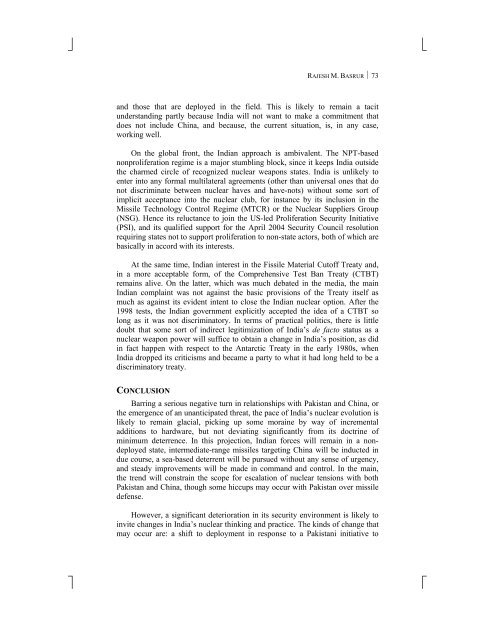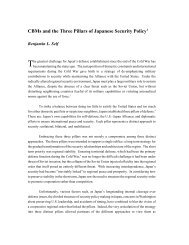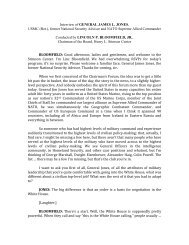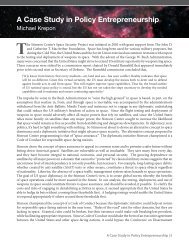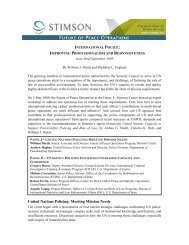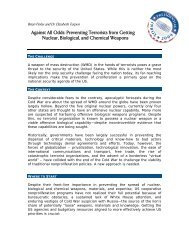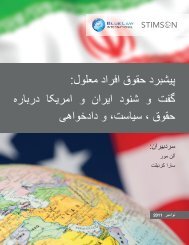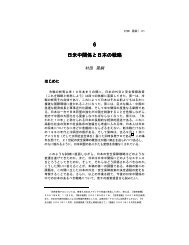India's Escalation-Resistant Nuclear Posture - The Stimson Center
India's Escalation-Resistant Nuclear Posture - The Stimson Center
India's Escalation-Resistant Nuclear Posture - The Stimson Center
Create successful ePaper yourself
Turn your PDF publications into a flip-book with our unique Google optimized e-Paper software.
⎦<br />
⎣<br />
RAJESH M. BASRUR ⏐ 73<br />
and those that are deployed in the field. This is likely to remain a tacit<br />
understanding partly because India will not want to make a commitment that<br />
does not include China, and because, the current situation, is, in any case,<br />
working well.<br />
On the global front, the Indian approach is ambivalent. <strong>The</strong> NPT-based<br />
nonproliferation regime is a major stumbling block, since it keeps India outside<br />
the charmed circle of recognized nuclear weapons states. India is unlikely to<br />
enter into any formal multilateral agreements (other than universal ones that do<br />
not discriminate between nuclear haves and have-nots) without some sort of<br />
implicit acceptance into the nuclear club, for instance by its inclusion in the<br />
Missile Technology Control Regime (MTCR) or the <strong>Nuclear</strong> Suppliers Group<br />
(NSG). Hence its reluctance to join the US-led Proliferation Security Initiative<br />
(PSI), and its qualified support for the April 2004 Security Council resolution<br />
requiring states not to support proliferation to non-state actors, both of which are<br />
basically in accord with its interests.<br />
At the same time, Indian interest in the Fissile Material Cutoff Treaty and,<br />
in a more acceptable form, of the Comprehensive Test Ban Treaty (CTBT)<br />
remains alive. On the latter, which was much debated in the media, the main<br />
Indian complaint was not against the basic provisions of the Treaty itself as<br />
much as against its evident intent to close the Indian nuclear option. After the<br />
1998 tests, the Indian government explicitly accepted the idea of a CTBT so<br />
long as it was not discriminatory. In terms of practical politics, there is little<br />
doubt that some sort of indirect legitimization of India’s de facto status as a<br />
nuclear weapon power will suffice to obtain a change in India’s position, as did<br />
in fact happen with respect to the Antarctic Treaty in the early 1980s, when<br />
India dropped its criticisms and became a party to what it had long held to be a<br />
discriminatory treaty.<br />
CONCLUSION<br />
Barring a serious negative turn in relationships with Pakistan and China, or<br />
the emergence of an unanticipated threat, the pace of India’s nuclear evolution is<br />
likely to remain glacial, picking up some moraine by way of incremental<br />
additions to hardware, but not deviating significantly from its doctrine of<br />
minimum deterrence. In this projection, Indian forces will remain in a nondeployed<br />
state, intermediate-range missiles targeting China will be inducted in<br />
due course, a sea-based deterrent will be pursued without any sense of urgency,<br />
and steady improvements will be made in command and control. In the main,<br />
the trend will constrain the scope for escalation of nuclear tensions with both<br />
Pakistan and China, though some hiccups may occur with Pakistan over missile<br />
defense.<br />
However, a significant deterioration in its security environment is likely to<br />
invite changes in India’s nuclear thinking and practice. <strong>The</strong> kinds of change that<br />
may occur are: a shift to deployment in response to a Pakistani initiative to<br />
⎤<br />
⎡


